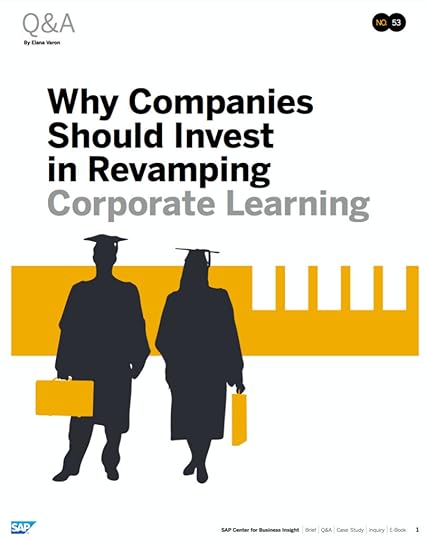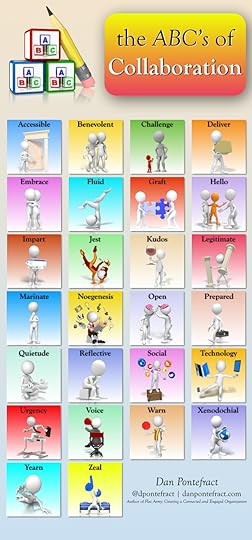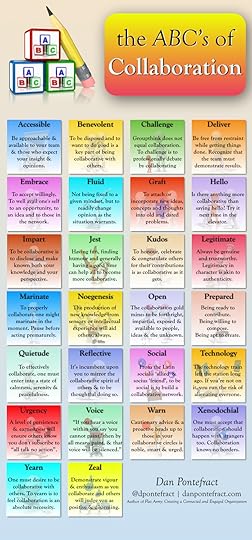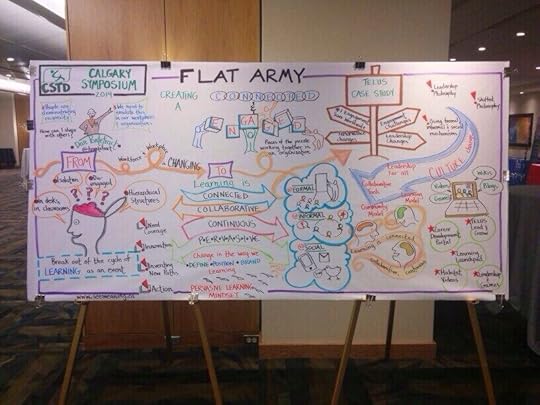Dan Pontefract's Blog, page 39
September 3, 2014
A 20-minute Talk About Collaborative Leadership
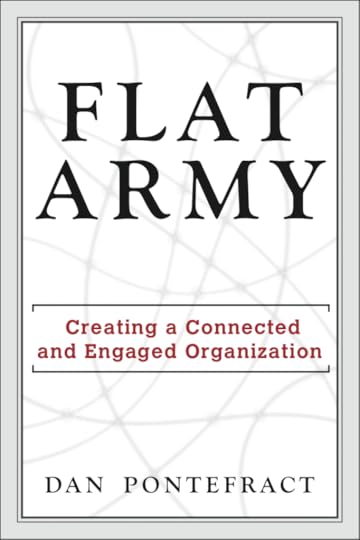 Here’s a 20-minute talk of mine, delivered at the SAP Sapphire Now conference in Orlando, Florida in June, 2014 where I discuss the Flat Army model, interspersed with metaphors and stories.
Here’s a 20-minute talk of mine, delivered at the SAP Sapphire Now conference in Orlando, Florida in June, 2014 where I discuss the Flat Army model, interspersed with metaphors and stories.
Dan's Related Posts:Flat Army CSTD Keynote as ArtFlat Army Book Trailer (one minute)Great Work Interview – Flat Army & Michael Bungay StanierThe Simple Act of TrustingIF
September 2, 2014
How B Corps Just Might Eliminate the Foolishness of Maximizing Shareholder Return
I absolutely love reading (and throw in writing, for that matter) non-fiction leadership books. Unless there are multiple editions, a book unfortunately runs the risk of potentially missing out on new developments or changes in the landscape since its original publication.
Take for example my first book, FLAT ARMY: Creating a Connected and Engaged Organization, written in 2012 and published in 2013 by Wiley.
Whilst I remain proud of the book — and my thanks to those who have bought it, and provided positive feedback to me directly — in hindsight there are certain elements I would subtract and add now that I can look back on it, two years since I finished the writing. It’s still a good book, in my eyes at least, but there are many elements I’d now change.
Take for example Benefit Corporations (more commonly known as B Corps) and how this sort of structure and ethos could aid many of the ills found within for-profit corporations today, specifically with respect to employee engagement. FLAT ARMY aims to help organizations build a more connected and engaged organization, and the example of B Corps, sadly, is missing from the book. I define employee engagement as;
“The state at which there is reciprocal trust between the employee and leadership to do what’s right however, whenever and with whomever.”
This seems to run through the heart of a B Corp.
What is a B Corp?
At its core, a B Corp is an incorporated company that intends to make a profit. That’s not really a surprise. It’s no different to what you’re used to in today’s for-profit organizations. There is a great divergence, however, from today’s profit hungry organizations and that of a B Corp. Benefit Corporations seek to take into account the welfares (and bottom line interests) of stakeholders that include the communities in which they serve, employees, environment, customers, products/services and its shareholders. A registered B Corp (adjudicated by the Certified B Corporation organization) must be “certified by the nonprofit B Lab to meet rigorous standards of social and environmental performance, accountability, and transparency” in order to achieve their accreditation and good standing.
As you might denote, B Corps are structured much differently than a traditional for-profit corporation. There is still a hierarchy — an executive team runs the company in addition to (if applicable) an elected board of directors to oversee governance and so on — but the measurement of success is vastly different. Whereas a traditional for-profit company is (usually) judged solely on its financial performance — with shareholder return being the de rigour metric of the past 30 years — a B Corp judges both financial and qualitative metrics as a basis for its success.
It DOES NOT solely measure success by financial targets.
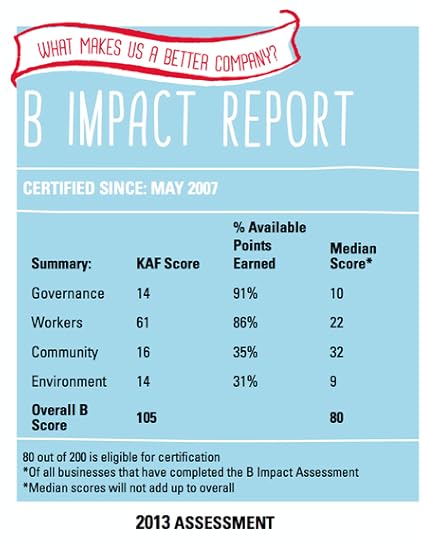 Take for example Vermont-based King Arthur Flour. They state the following on their website: “Being a good steward of our community and our environment, treating our employees and our business partners with respect, and remaining steadfast in our commitment to quality has been King Arthur Flour’s recipe for success for more than 220 years.” They back this statement up in many ways, not the least of which is their publicly available annual report. Aside from their community and environmental targets that were achieved, the company reports the following on their compensation practices:
Take for example Vermont-based King Arthur Flour. They state the following on their website: “Being a good steward of our community and our environment, treating our employees and our business partners with respect, and remaining steadfast in our commitment to quality has been King Arthur Flour’s recipe for success for more than 220 years.” They back this statement up in many ways, not the least of which is their publicly available annual report. Aside from their community and environmental targets that were achieved, the company reports the following on their compensation practices:
King Arthur Flour believes in paying at or better than a livable wage. We currently pay all regular employees at least 14% above livable wage.
Profit sharing is paid when the company achieves certain financial targets. All eligible employees draw from a pool amount according to a formula set by the Board of Directors each fiscal year.
An Employee Stock Ownership Plan (ESOP) is an important part of total compensation for King Arthur Flour employees. The ESOP helps tie us together as one company, making it clear that we succeed by succeeding together. The amount in each employee’s account increases based on company contributions, our stock price growth and person’s tenure at King Arthur Flour.
Could it be this good? Could B Corps have established an operating model that might curb employee disengagement while continuing to meet financial goals … all the while doing good in the community and for the environment, while not losing sight of the customer?
I reviewed the websites of many registered B Corps (there are over 1000 at the time of this writing) including the likes of Schoolzilla, Ben & Jerry’s, Etsy, and Canada’s own Bullfrog Power and by the time I got through them all, I was grinning ear to ear.
What’s the Problem?
The good news is a B Corp refuses to focus its sole identity and operating mantra on the shareholder. Thus, the “world’s dumbest idea” — maximizing shareholder return — gets equal billing to the employee, community, customer and environment in the running of a B Corp.
But how did we get to a place where those for-profit organizations became myopically fixated on maximizing shareholder return, and seemingly scoffed at the other stakeholders such as community, employees, customers and the environment? Roger Martin, Academic Director of the Martin Prosperity Institute at the Rotman School of Management, informed us in Harvard Business Review that, “After Michael C. Jensen and William H. Meckling published “Theory of the Firm: Managerial Behavior, Agency Costs and Ownership Structure” in the Journal of Financial Economics in 1976, “maximizing shareholder value” became the new corporate mantra.” Arguably, Jensen and Meckling were building off of Milton Friedman’s 1970 essay in The New York Times Magazine entitled “The Social Responsibility of Business is to Increase its Profits”, where he stated, “there is one and only one social responsibility of business-to use it resources and engage in activities designed to increase its profits so long as it stays within the rules of the game, which is to say, engages in open and free competition without deception or fraud.”
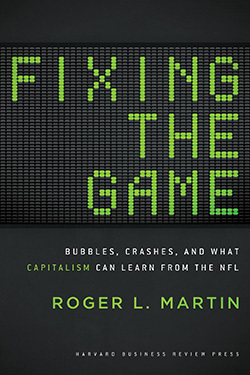 B Corps weren’t defined prior to 1976, but it’s fair to suggest many organizations were unknowingly being run as a B Corp, before the advent of “maximizing shareholder value.” Once CEO’s and Management Boards clued in to this magnetic vortex of financial gains (both personally and organizationally), it became the way a company was managed.
B Corps weren’t defined prior to 1976, but it’s fair to suggest many organizations were unknowingly being run as a B Corp, before the advent of “maximizing shareholder value.” Once CEO’s and Management Boards clued in to this magnetic vortex of financial gains (both personally and organizationally), it became the way a company was managed.
There have been many opponents to the adage, “maximizing shareholder value” backing up Roger Martin’s thesis in his classic book, “Fixing the Game”. Rick Wartzman, executive director of the Drucker Institute at Claremont Graduate University, for example, wisely stated at Time, “Building a company to be sustainable, and assessing its progress toward that end, is complicated; “maximizing shareholder value” is, by contrast, seductive in its simplicity.” The B Corp concept is not easy — after all, there are five different stakeholders to manage — but the draw of financial gains is indeed seductive if that’s what everyone else is doing. It’s a new albeit uglier form of “keeping up with the Joneses”.
Steve Denning, author of The Leader’s Guide to Radical Management: Reinventing the Workplace writes at Forbes, “CEOs and their top managers have massive incentives to focus most of their attentions on the expectations market, rather than the real job of running the company producing real products and services.” Steve has long been an opponent of “maximizing shareholder value” and his recent example highlighting IBM cuts sublimely to the core of the matter:
“As revenues fall, IBM’s higher earnings targets are met through relentless cost cutting, tax reduction gadgets and share buybacks funded by borrowing. While IBM’s share price soars, as the top managers and big investors extract cash from it in a weird kind of reverse-Ponzi-scheme, IBM steadily becomes an increasingly unproductive shell, a mere shadow of its once truly-innovative self. As a triumph of financial engineering, IBM “makes money from money,” while its future is being systematically destroyed. How many more of such disasters will we have to witness before the shareholder primacy idea finally dies?”
Over the course of an interview with the Financial Times in 2009, former General Electric CEO, Jack Welch even said, “On the face of it, shareholder value is the dumbest idea in the world. Shareholder value is a result, not a strategy … your main constituencies are your employees, your customers and your products. The idea that shareholder value is a strategy is insane. It is the product of your combined efforts – from the management to the employees”. Unbeknownst to Jack, he may have been setting us up for the introduction of B Corps, although at least in this interview, he neglected the tenets of community and the environment.
What Have Been Consequences on the Worker?
The top 100 compensated CEO’s in America pulled in a hair short of $3 billion in 2012. Larry Ellison Jr., CEO of Oracle Corporation, topped the list with $96,160,696 in earnings. Number 100 was Alexander Smith, CEO of Pier 1 Imports Incorporated who took home $18,755,923 in total compensation. For comparison sake, according to the United States Social Security Administration, the median wage in the U.S. in 2012 was $27,519.10, which is up ever so slightly from 2011′s median wage of $26,965.43. When adjusted for inflation, however, the median wage remains virtually unchanged since 1998 where it stood at $27,519.55 when adjusted for inflation. Americans actually earned less in 2012 than in 1998.
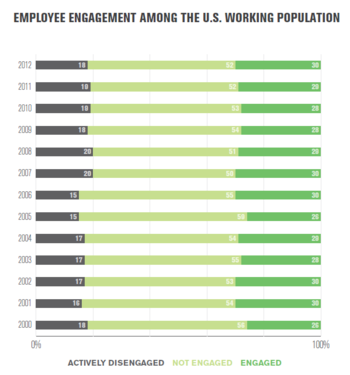
Do you think the top 100 CEO’s in America were compensated $3 billion by way of a bi-weekly paycheque, or perhaps you would agree the bulk of that wealth came in the form of stock options and restricted stock units, by way of increasing shareholder value over time? If you’re an employee of the organization, without the financial means or performance output to partake in said shareholder wealth, how might you be feeling if your senior leaders are becoming über rich, and you’re total personal compensation is actually trending downward? And we wonder why — in part at least — employee engagement levels remain woefully anemic, according to Gallup, AON Hewitt or BlessingWhite.
In Canada, and according to the Canadian Centre for Policy Alternatives (CCPA), it’s no different from the data points I outlined above regarding America. Based on 2012 compensation levels, Canadian CEO’s earn on average close to $8 million per year totalling roughly 171 times the average take-home pay of Canadians. Since 1998 that figure is up 105 times the average wage. Canadian workers average $46,634 in compensation, only $7.95 million shy of the CEO average in Canada. Notice any correlation to maximizing shareholder value?
According to the non-partisan Economic Policy Institute, between the years 1978 and 2011, CEO pay in America increased by more than 725 percent. Paradoxically, the Federal Reserve Bank of St. Louis reported that worker productivity actually increased by 93 percent over the same time period. But this is where things seriously go askew. What has a regular worker’s pay gone up by over that same time period? Would you be surprised to know that the wages of common workers have increased by … wait for it … only 5.7 percent. There seems to be quite a gap between pay and productivity. Add to this the irrefutable fact global levels of employee engagement have not significantly increased since firms started measuring the metric in the late 1990′s, and you have yourself a recipe for disengaged organizations.
B Corps to the Rescue
 If America had some form of B Corp knighthood, I’d be the first to recommend Arthur T. Demoulas to be knighted. Market Basket is a supermarket chain of 71 stores in Massachusetts and New Hampshire, with new ones about to launch soon in Maine. The company employs over 25,000 workers. I might add Market Basket is run like a B Corp, where employees receive better pay (than its competitors), customers enjoy lower prices (than its competitors), a focus on community and the environment is a fixture … and it’s all accomplished by paying shareholders smaller dividends (than its competitors).
If America had some form of B Corp knighthood, I’d be the first to recommend Arthur T. Demoulas to be knighted. Market Basket is a supermarket chain of 71 stores in Massachusetts and New Hampshire, with new ones about to launch soon in Maine. The company employs over 25,000 workers. I might add Market Basket is run like a B Corp, where employees receive better pay (than its competitors), customers enjoy lower prices (than its competitors), a focus on community and the environment is a fixture … and it’s all accomplished by paying shareholders smaller dividends (than its competitors).
Imagine that.
When Arthur T. (the company’s fearless leader) decided in 2013 to offer his customers an additional 4 percent discount — suggesting his customers could probably use the money more than the company’s shareholders — a coup d’état was put in motion, and Arthur T. was ousted as its top leader. Even after volumes of sales increased, and its low employee turnover became even lower, Arthur T. was sent to the grocery sidelines. Interestingly, factions of his own family ousted him. (That ought to be a difficult Christmas this coming December)
But then a Hollywood script broke out. The workers — you know, the ones who were being treated so well under Arthur T’s leadership — exerted their ‘purpose before profit’ company ethos, and walked out. Over a six-week period, the Market Basket employees stuck up for their fearless leader, and over negotiations, lawyers and I imagine a few bottles of Scotch, Arthur T. Demoulas announced he had reached a settlement with his shareholder value fixated family members, and bought back the company for $1.6-billion, assuming operations and leadership of the chain again. Once news reached the employees, I imagine backflips and cartwheels were performed in parking lots across the two states where they currently have stores.
It’s but one example, however Market Basket serves us with a few lessons.
Most importantly, employees want to feel that they’re a part of something. Fair compensation is one thing, but for an employee to truly be engaged, they want the company that they work for to be a true corporate citizen that pays equal attention to the five tenets of a B Corp. As Market Basket informs us, sometimes those investments in customers, employees, environment and community come as a result of lowering shareholder value, not maximizing it. Take that Jensen, Meckling and Friedman.
It’s also a concept I’m extremely familiar with at the very place I work, TELUS, a telecommunications company. Since 2000, for example, TELUS and its 44,000+ team members have donated over $350 million to the communities it serves and we have volunteered more than 5.4 million hours of our own time. The environment is a key tenet as well. By way of our revolutionary Work Styles program, in 2013 we reduced our carbon (CO2) footprint by 4,365,000 kilograms. Our team members are flourishing, making Martin Seligman proud I’m certain. Between 2007 and 2013, our employee engagement levels rose from 53% to 83%, with AON Hewitt informing us that, “The TELUS engagement score is #1 globally amongst organizations of its size and composition.” Add in our commitment to the Customers First program while — still, one might argue — becoming the global leader amongst all telecom service providers since 2000 with a total shareholder return of 286 per cent, outpacing the number two incumbent by 110 percentage points. Technically, TELUS isn’t a certified B Corp, but one might argue it really is a B Corp, one that happens to also post $11.4 billion in annual revenues.
Imagine that.
In summary, if Wiley ever asks me to write a second edition of FLAT ARMY, you can be assured B Corps become an entire section, if not a new chapter to the book. Maximizing shareholder return is not sustainable, nor is it the way in which a corporation should be run. B Corps, however, just might provide a little levity if not innovation to curbing this financial only fallacy of shareholder return myopia once and for all.
PS. If you’re a visual and audible learner, Jay Coen Gilbert delivers a superb TEDx Talk entitled “On Better Business” that details the nuances of B Corps.
Note: cross-posted to Huffington Post.
Dan's Related Posts:Can Humanism Replace Capitalism?Bill Sullivan, CEO of Agilent Technologies is a Chief Engagement OfficerCan Employee Engagement Improve Customer Satisfaction?Flexible Working WorksClowning Around – An Important Leadership Attribute
August 27, 2014
Rethinking Approaches to Corporate Learning
 Elana Varon of the SAP Center for Business Insight recently interviewed me with the topic and questions focusing on different approaches to corporate learning.
Elana Varon of the SAP Center for Business Insight recently interviewed me with the topic and questions focusing on different approaches to corporate learning.
The full report, entitled Why Companies Should Invest in Revamping Corporate Learning — with additional insights from Marcus Schwarz and Karie Willyerd of SAP — is available at this link. I encourage you to download it. (it’s free) My specific responses are below.
Elana: Do employers have an obligation to train and develop their employees?
Pontefract: We consider it a responsibility of TELUS team members to participate in learning. There are a lot of tools we make available. But we’re really trying to take care of our people. It’s not the case that they have to go figure everything out for themselves. The model is for leaders to assist.
Elana: Companies still seem to be very invested in classroom-style learning (both online and offline) rather than in facilitating collaboration. How do they need to change?
Pontefract: Companies need to blend that learning model into the corporate culture. Often, marketing or IT is in charge of deciding what collaboration tools employees will use and showing people how to use them. Meanwhile, the learning function within HR is playing catch-up. But the learning function should be leading, or at least working in parallel with other functions.
Elana: What do you think about expanding the role of corporate learning to include the whole ecosystem of business partners, freelancers, and contractors?
Pontefract: You have to make a judgment call as to what type of relationship you have with a particular contractor when you decide who should have access to your training programs and whatever informal or social learning opportunities people have internally. But in general, hiring fewer full-time employees and relying more on contractors or freelancers – which many companies are doing today – means that fewer people inside your company are learning the skills they need to accomplish the work.
Dan's Related Posts:It’s Time to Revolutionize Corporate LearningRethinking the Work of LeadershipEmployee Access to Social Media in the Workplace DecreasesGreat Work Interview – Flat Army & Michael Bungay StanierAfter Five Years In My Role We’re Hiring My Replacement. Are You Interested?
August 25, 2014
Two Very Incredible & Courageous Women
I wouldn’t call the two incredible and courageous women in this story ‘good friends’ with me nor are we ‘best friends’, but we’re certainly not ‘bad friends’ or ‘former friends’, so let’s just go with the fact we’re ‘connections’ and leave it at that.
The purpose of this story is to share, to enlighten and to articulate incredible courage … as best I can.
My two connections are — to say the least — going through a form of hell on wheels with their health. In one corner, we have E.T. (the extra terrestrial) literally fighting for a new heart, eager to return home one day and resume a relatively normal, life of botany. (Heck, throw in pounds of overindulging in Reese’s Pieces too)
In the other corner, imagine we have Rocky Balboa – but with cancer. Not the Rocky from movies number two through thirteen, but the original Rocky – the ultimate definition of resilience, perseverance and courage. “Adrian!!” (You know you want to yell that line very loudly right now)
Now it may seem weird to bring up E.T. and Rocky as metaphors, when (as far as I can tell) both of these characters are males and I’m about to discuss “Two Very Incredible & Courageous Women”, but they were the first movie-related ‘actors’ that came into my mind. You can ‘flame me’ in the comments section below.
Story #1. E.T.
During the summer of 2011, an academic friend of mine was teeming with excitement. Her friend (Jillianne) was rooting down in Victoria, British Columbia having accepted an offer as a Faculty member at the University of Victoria. My friend was eager for her to move from Boston (where she was completing a Postdoctoral Fellowship at Harvard University) to Victoria. Jillianne was going to become co-Director of the TIE Lab (where my friend was already a Director) and the concept itself was something I was personally and professionally enamored with.
The purpose of the TIE Lab is to “strengthen research excellence regarding the appropriate use of networked and computer‐mediated technologies for enhanced communication, learning, and motivation across educational, professional, and health sectors.” Now you know why I love it.
 When I met Jillianne for the first time in 2011, face-to-face over a make-shift fire where actual marshmallows were roasted, it was evident to me her passions and purpose were tailor-made for the TIE Lab. We delved effortlessly into various forms of collaborative and social technologies, educational theories, and music! “Yes,” I said to myself. Jillianne is the full package.
When I met Jillianne for the first time in 2011, face-to-face over a make-shift fire where actual marshmallows were roasted, it was evident to me her passions and purpose were tailor-made for the TIE Lab. We delved effortlessly into various forms of collaborative and social technologies, educational theories, and music! “Yes,” I said to myself. Jillianne is the full package.
Little did I know, however, that Jillianne moved to Victoria with a back-story unlike many others. Back in the Summer of 2005, Jillianne was diagnosed with “congestive heart failure” and her family was told to “prepare for the worst.” Imagine the burden you would face in your life, when for more than half a decade you were told things didn’t look so hot for your (to be blunt) life. Talk about being dropped off on the planet, and your home ship leaving you to figure things out for yourself – like E.T. had to. #not #awesome #sauce
But Jillianne is an out-of-this-world human being. She is literally pushing herself out of a premature body bag (like E.T., with her heart glowing like the aurora borealis) and in parallel, she is sharing her story, teaching others what it’s like to live a life of congestive heart failure. How? Given her background, are you surprised to learn she is openly blogging at a site she calls, “Heart Failure to Harvard?”
Our time together, face-to-face, has been brief, but her courage and incredible resiliency — not to mention her decision to continue teaching from a hospital bed, by way of her blog — is nothing short of magisterial. She is brilliant, humbling … and I am in awe of her hearty ‘joie de vivre’. E.T. phone home, please.
Story #2. Rocky
Many, many moons ago, a chap by the name of Pete used to work with me at Business Objects. He was a media developer. He was really good too. More importantly, he was whipped. When I write, ‘whipped’, I truly mean it … and not in a Russell Crowe/Gladiator sense. The love of his life, Carissa, sat in photo form on his desk, radiantly beaming back with the kind of eyes people fishing on eHarmony and Match.com openly yearn for. Needless to say, their two girls are ridiculously photogenic and gorgeous as well.
One day in 2006, Pete said he was moving to Victoria – a 120 kilometer journey from Vancouver but separated by the Georgia Strait. (it’s a big body of water, and only drunk people kayak or canoe back and forth) We had no “work from home” policy, program or compassion at the time, but even though Pete asked if he could “work from home”, we (the ‘company’) had to say our good-byes. “Poor Pete – he has to live in Victoria now,” I muttered to myself (now ironically) on his last day.
 Fast-forward to 2009 and wouldn’t you know it, I’m in a meeting with those radiantly beaming eyes. Ya see, Carissa works for TELUS (I think since forever) and when I joined up the fluffy bunny telecommunications company myself, we would occasionally be in the same meetings. If she were from Boston (she’s not) you might say she is “wicked smart”, but I digress. In a nutshell, she is the quintessential TELUS team member. (and wicked smart)
Fast-forward to 2009 and wouldn’t you know it, I’m in a meeting with those radiantly beaming eyes. Ya see, Carissa works for TELUS (I think since forever) and when I joined up the fluffy bunny telecommunications company myself, we would occasionally be in the same meetings. If she were from Boston (she’s not) you might say she is “wicked smart”, but I digress. In a nutshell, she is the quintessential TELUS team member. (and wicked smart)
I vicariously watched her develop cancer, beat the shit out of it, and continue to be “wicked smart”. Awe inspiring doesn’t begin to describe Carissa. She is incredible and courageous.
Earlier this year, death decided to knock on the door again for Carissa, Pete and the girls. The antagonist known as cancer returned, and not in a funny, Griswold family vacation way. But, despite the cancer being metastatic, Carissa is continuing her “wicked smart” ways, demonstrating it by openly blogging (I prefer to call it screenwriting) how incredible and courageous she really is. Her writing is exquisite. Spielberg or Stallone can only wish they wrote this well.
But it’s not the fact she is funny, honest, bad-ass (her words) or descriptive … it’s that she’s openly writing in the first place. Like Jillianne, Carissa is teaching. She’s teaching anyone – young girls, young boys, old girls, old boys – that life isn’t about letting go, it’s simply about defining the word ‘go’.
She could have cowered. She could have curled up into the fetal position and given up. She could have chosen to be a Brian Wilson or Howard Hughes recluse, but no. She didn’t. She’s bad-ass. She’s a teacher and a communicator.
You want real irony? I now live in Victoria (where Pete wasn’t allowed to work from, back in 2006) and I still haven’t seen Carissa in the three years I’ve lived in Victoria. Ok, I spend a lot of time in cities other than Victoria — and have seen Carissa in Vancouver — but c’mon, like with Jillianne, what kind of ‘connection’ am I really?
In Summary
Albert Einstein once said:
There are only two ways to live your life. One is as though nothing is a miracle. The other is as though everything is a miracle.
Jillianne and Carissa, you both are Victoria miracles. I wish you could meet one another. Everything you do is miraculous. I’m so proud to know you — even as a connection — and am deeply moved by how incredible and courageous you are treating your respective situations. My goats will know your story, rest assured.
For you, the reader, please consider visiting and reading their blogs (Jillianne and Carissa) from the very first entries, and drown yourself in their incredible, courageous teachings.
You won’t regret it.
Clearly, they don’t mind teaching.
You shouldn’t mind learning.
Dan's Related Posts:It’s About Leadership: Ryder Hesjedal & the Giro d’Italia WinIs Facebook a Narcissistic Walled Garden?When Life Flashes Before Your EyesOur Three Young Children Blog … Here’s WhyWhat I Learned From My Daughter About Decision Making
July 26, 2014
My Definition of Work and an Update on Book Two
 Like my first book, Flat Army: Creating a Connected and Engaged Organization, Book Two has taken a decided turn for the better.
Like my first book, Flat Army: Creating a Connected and Engaged Organization, Book Two has taken a decided turn for the better.
Originally, Flat Army was written as a fable. The original title was “The Coffee Shop Leader”. One day, I may even release the entirety of the book in its original format.
But I received timely and magical guidance from a few people, most notably Don Loney, and the rest is history.
The same can be said for this next book. I had written 45,000 words and through various pieces of feedback and counsel, the book has morphed. Originally, I had thought of calling it, “It’s Work Not Jail: The Difference Between a Job and a Career with Purpose”. The problem rested with its target audience. I was lost between leaders, employees and anyone in between.
I was trying to win a Stanley Cup without properly drafting solid players and putting in the foundations for a winning team over time. I was trying, it seems, to buy an instant Stanley Cup winner without focusing on the right audience of players and mechanics to succeed.
So, IWNJ has been altered to focus more clearly on the actual target audience that needs assistance. (at least in my opinion)
Leaders!
The next book is focused on leaders.
The title will remain a mystery (the original has been scrapped) but it’s fair to say leaders of any stripe could use a refreshing jolt of reality when it comes to developing the careers of those they serve — the employees of the organization and thus the team(s) they lead.
As I’ve personally pivoted during the writing stage of this next book, I’ve found my writing mojo once again. Interestingly, I wasn’t enjoying the writing process up until the past month or so, and I’m a year into it. Three target audiences were causing me strife. I was trying to address too much, and as a result the writing seemed to be less specific than it ought to be.
The following paragraphs are from the new Chapter One, to help position what I’m up to:
This book is about hope, and it’s written for one reason, and one reason only: to refute career development mediocrity and workplace leadership melancholy. I want to see you break free and realize your responsibility as a leader is to find (and define) purpose in the careers of those you are leading, whether your profession is in finance, travel, entertainment, mining, high-tech and so on. I care that you have the skills to help others define what a career with purpose ought to feel like.
You must recognize you have a responsibility in the development of your people and their careers. The dynamic that is at play here is the innate desire of employees to be creative problem solvers and meaningful contributors to the organization against the restraints of their organizational culture and leadership misdirection. It’s time to remove the shackles. It’s time to help foster a purposeful career with the people you are leading. This book aims to not only define the difference between the mindsets of a job, a career and one with a purpose, it showcases the methods to help others build up the skills and muscles to achieve such role-based satisfaction.
The quest a leader should be on is to not only help employees build their careers and achieve purpose in their employment role … it should be to properly redefine the purpose of work itself. This is why I’ve defined the word “work” as follows:
“The link between individual remuneration and workplace effort, that creates personal and organizational value through a career full of purpose.”
I’m excited. (again)
The journey continues. (again)
More to come.
Thanks for reading.
Dan's Related Posts:Lessons Learned From a First Time AuthorCoaching Should Be An Expectation Of All Connected LeadersMy Next Role Is …the FLAT ARMY cheat sheetAutotelic: The Word of 2013
June 23, 2014
The ABC’s of Collaboration
(Editor’s Note: scroll down for graphical versions)
In my book, Flat Army: Creating a Connected and Engaged Organization (Wiley) I define collaboration as follows:
The unfettered allowance and encouragement of employees to both contribute and consume knowledge, insight or ideas with any direct relationship via professional or personal networks to achieve an outcome.
If we were to elaborate on the definition, we might suggest there are ‘The ABC’s of Collaboration’:
Accessible – Be approachable & available to your team & those who expect your insight & opinions.
Benevolent – To be disposed and to want to do good is a key part of being collaborative with others.
Challenge – Groupthink does not equal collaboration. To challenge is to professionally debate by collaborating.
Deliver – Be free from restraint while getting things done. Recognize that the team must demonstrate results.
Embrace – To accept willingly. To well avail one’s self to an opportunity, to an idea and to those in the network.
Fluid – Not being fixed to a given mindset, but to readily change opinion as the situation warrants.
Graft – To attach or incorporate new ideas, concepts and thoughts into old and dated problems.
Hello – Is there anything more collaborative than saying hello? Try it next time in the elevator.
Impart – To be collaborative is to disclose and make known both your knowledge and your perspective.
Jest – Having fun, finding humour and generally having a good time can help all to become more collaborative.
Kudos – To honour, celebrate & congratulate others for their contributions is as collaborative as it gets.
Legitimate – Always be genuine and trustworthy. Legitimacy in character is akin to authenticity.
Marinate – To properly collaborate one might marinate in the moment. Pause before acting prematurely.
Noegenesis – The production of new knowledge from sensory or intellectual experience will aid others, always.
Open – The collaboration gold mine: to be forthright, impartial, exposed & available to people, ideas & the unknown.
Prepared – Being ready to contribute. Being willing to compose. Being apt to create.
Quietude – To effectively collaborate, one must enter into a state of calmness, serenity & peacefulness.
Reflective – It’s incumbent upon you to mirror the collaborative spirit of others & to be thoughtful doing so.
Social – From the Latin socialis ‘allied’ & socius ‘friend’, to be social is to build a collaborative network.
Technology – The technology train left the station long ago. If you’re not on it, you run the risk of alienating everyone.
Urgency – A level of persistence & earnestness will ensure others know you don’t subscribe to “all talk no action”.
Voice – “If you hear a voice within you say ‘you cannot paint,’ then by all means paint, & that voice will be silenced.”
Warn – Cautionary advice & a proactive heads up to those in your collaborative circles is noble, smart & urged.
Xenodochial – One must accept that collaboration should happen with strangers too. Collaboration knows no borders.
Yearn – One must desire to be collaborative with others. To yearn is to feel collaboration is an absolute necessity.
Zeal – Demonstrate vigour & enthusiasm as you collaborate and others will judge you as positive & disarming.
There are two infographic versions of “The ABC’s of Collaboration” found below. Feel free to use them.
I’m taking a writing break for the summer. See you in September-ish. Thanks for visiting.
Dan's Related Posts:the FLAT ARMY cheat sheetLearning by OsmosisKudos Jacques Godin, an Engaged Air Canada EmployeeFuture Of Work: A Flat Army Of Open Leadership via A.G. LafleyAutotelic: The Word of 2013
June 16, 2014
10 Insights to Create a Connected and Engaged Organization
 The fine folks at 33 voices put together an outstanding Slideshare program of thoughts and quotes from me, as it pertains to creating a connected and engaged organization.
The fine folks at 33 voices put together an outstanding Slideshare program of thoughts and quotes from me, as it pertains to creating a connected and engaged organization.
Big thanks to Moe Abdou and team.
I hope you can utilize it in the organization where you currently work.
Dan's Related Posts:Flat Army Graphics on SlideshareDownload Chapter 1 for Free – Flat Army: Creating a Connected and Engaged…Flat Army: An Overview of the Bookthe FLAT ARMY cheat sheetRethinking the Work of Leadership
June 11, 2014
An Ode to Hierarchy
You there,
With the jaundice coloured leadership grin.
As wise souls have said before me, prematurity breeds immaturity.
Where art thou braggadocio in your moment of ascension?
There it is,
Plentiful for all to witness like a storm that blankets Tuktoyaktuk in winter.
We have seen it before in this very agora.
Cold. Harsh. Unforgiving.
Unrelentingly demonstrating who reigns from above, who is the arkhēs.
But this pack of snow is neither fluffy nor pretty.
It is ice.
It is thick (headed).
It is infrangible.
Callowness reigns abetted by your penchant for nepotism.
Don’t fret.
The halls, they scream in whispers of discontent and of shuddering disbelief.
This misbegotten decision and your reinforcement of hierarchy is the new now.
My hope remains because “The future depends on what you do today.”
“An Ode to Hierarchy” by Dan Pontefract, June, 2014
Dan's Related Posts:Hierarchy for the Sake of Hierarchy is Simply Being GutlessThe Hierarchy of EducationLinkedIn is not Facebook so Please Think Twice About Your UpdatesCredo of the Collaboration CanoeThat Decision Is Above My Pay-Grade
June 9, 2014
The Volkswagen Commercial That Depicts a Backwards Workplace
It’s only a 30-second commercial, but it rubs me entirely the wrong way.
 I suspect the advertising agency for Volkswagen wasn’t thinking about the backwards way in which they depicted the workplace (or life) throughout the commercial, but the evidence is as clear as day to me.
I suspect the advertising agency for Volkswagen wasn’t thinking about the backwards way in which they depicted the workplace (or life) throughout the commercial, but the evidence is as clear as day to me.
I have a few observations:
Dad is stuck at work, whereas Mom is gleefully sitting in at the auditorium, watching her son’s violin recital.
Does this suggest Mom doesn’t work? Or does she simply have a more lenient employer? Did she have to take a day off to watch?
There is an empty seat to the left of Mom.
Does this imply Dad was supposed to attend but couldn’t? If he couldn’t, what were the reasons? “Emergency” meeting? Did he forget about the recital? Did his boss say “no” when he asked that morning?
Dad excused himself from the meeting to listen to the recital via the Passat mobile phone sound system, but he didn’t attend in person.
Will there ever be another moment like the one where he missed his son’s recital? What type of employer is he working for that doesn’t permit him to excuse himself for a short period of time? How will it affect the son, over time?
Yes, there are rebuttals to each of my questions.
Mom is a teacher at the school. Dad is away on business, in another city. There are other men in the auditorium. He did ‘hear’ the performance, Dan.
That being stated, the commercial rubs me entirely the wrong way.
It’s Dad who’s at work.
It’s Mom who is watching the performance.
It’s Dad who can’t get away from the office.
It’s Mom who is holding up a phone so Dad can partake.
It’s Dad who works for an organization that clearly doesn’t demonstrate life-work flexibility.
It sends a message, a signal, a doctrine that is tiresome, over-played and rooted in history.
Our workplaces can do better.
Our lives can be lived better.
That father should have been at the recital.
Our workplaces need to become more humane.
Dan's Related Posts:Employee Access to Social Media in the Workplace DecreasesHere’s to the Crazy OnesYa, I Cry at Work. Do You?Five Essential Tips to Effectively Work from HomeVirtual Worlds in an Organization are not a Time Waster (and other beefs)
June 5, 2014
Flat Army CSTD Keynote as Art
I had the chance to deliver the CSTD Symposium keynote in Calgary, Alberta on June 5, 2014. Hopefully audience members came away with a nugget or two of inspiration or ideas for change.
I can safely report no tomatoes were launched on stage.
The inimitable Corrie Melanson of seemeaning.ca captured the talk as a graphic.
Correction: it really is art.
Thanks Corrie for a fab piece of work. Thanks Team CSTD for the chance to speak, and for hiring Corrie to capture my talk.
Dan's Related Posts:Internet Activities Do NOT Affect Adolescence DevelopmentA Twitter Conversation With Myself About Culture and CetaceansGive Piece a ChanceThe Simple Act of TrustingThe TED of all Leadership Management Conferences – A Review of the Drucker Forum…

